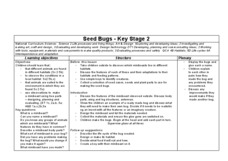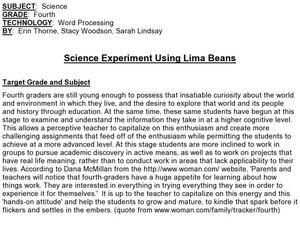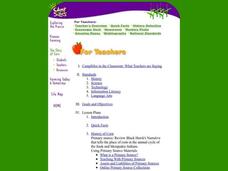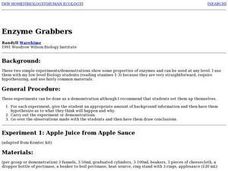Curated OER
Seed Bugs; Stage 2
Students examine nature by participating in an environmental art activity. In this imaginary creature activity, students discuss the importance of a habitat when pertaining to wild animals or bugs. Students utilize tree parts which they...
Curated OER
Salt is Good On Sunflower Seeds, But What About Cypress?
Students record their observations about growing a cypress plant and putting salt in the plant. In this cypress plant lesson plan, students observe and record what is happening as the cypress plant grows. This gives directions for...
Curated OER
From Seed to Apple
Students identify the stages of apple growth. In this agricultural lesson plan, students read the story I Am Apple and sing the song "Round the Apple Tree." Students place pictures of the stages of an apple into the correct order....
Curated OER
Seed to Market
Students research using a variety of materials and technology. They explain the specifics of growing crops. They use mathematics in common business calculations.
Curated OER
Earth Day - Grow A Seed Garden
Students discover how things grow and how they can take better care of the environment in this Earth Day lesson for the elementary classroom. The activity can be accomplished in one day and left in the sun until the "beans" begin growing.
Curated OER
Make a Flower
In this flower cut out worksheet, students cut out the pieces of the flower and the labels. Students then assemble the flower on another sheet of paper and label each part. This worksheet contains 7 labels and 20 flower pieces.
Curated OER
From Seed to Plant: Spelling
In this plant vocabulary learning exercise, students choose the word that is spelled correctly out of the 4 words in each list regarding plant vocabulary. Students circle 15 words.
Curated OER
Science Experiment Using Lima Beans
Fourth graders tie together elements about the world and their environment. Students incorporate styles of higher order thinking skills. Students measure skills of observations, conclusions, inferences and predictions.
Curated OER
Apple Science
Sixth graders experiment with different ways to test an apple for ripeness. In this apple harvesting lesson, 6th graders conduct three different experiments to test apples for ripeness and carry-out four additional activities involving...
San Francisco Public Utilities Commission
Hetch Hetchy: The Story of San Francisco's Water
How did San Francisco supply enough water for its residents over the last two centuries? Learn about droughts and water conservation in California, as well as specific historical events that led to the water system today. Kids read two...
Perkins School for the Blind
Creating a 3-D Model of a Plant Life
Instructing blind or visually impaired learners means you need to make symbolic tactile representations of various processes to provide as much input as possible. But wouldn't it be even better to have your learners make the models...
Curated OER
Whitewater Canal State Historic Site
If you happen to live in Indiana, or a neighboring state, and are planning a field trip to the Whitewater Canal State Historic Site, then this lesson plan will suit your needs quite well. In it, suggestions for activities before, during,...
Curated OER
Indoor Gardening
Students determine how a plant grows best. In this botany lesson, students observe variables that affect plant growth. Students explore how to grow and maintain a plant. Students make observations of their plant as it grows.
Curated OER
Little Red Hen
Learners thresh wheat. In this comprehension and comparison lesson, students read the Little Red Hen and retell the story based on the beginning, middle and end. Learners get a wheat stem, predict the number of seeds in their seed head,...
Curated OER
Soil pH Effect on Germination of Specific Weeds
Students collect weed seeds from three varieties of weeds (knapweed, thistle, or toadflax, for example they may choose others in addition to the spotted knapweed.) They sterilize soil for thirty containers, plant seeds in sterile soil,...
Curated OER
Paleoclimates and Pollen
Students analyze soil for types of pollen to determine the probably climate conditions. In this earth science lesson, students make conclusions on what a climate is like based on soils samples. Students use a model soil...
Curated OER
Rain
First graders practice oral and silent reading using beginning comprehension and decoding strategies. In this guided reading lesson, 1st graders take a picture walk and make plot predictions prior to reading the book Rain by Robert...
Curated OER
The Story of Corn
Students use primary sources to compare the early development of corn with current techniques of biotechnology and genetically engineered seeds, and identify plants natural to the Americas and those natural to Europe that were part of...
Curated OER
How Does Your KinderGarden Grow
Students find forecast and graph weather by using WeatherBug site, create flower books by using Wiggleworks, and plant radish seeds both on KidPix and in class garden.
Curated OER
Milkweed Monitoring
Young scholars monitor milkweed plants from their emergence in the spring to the time when they go to seed in the fall. They measure their height and the number of leaves on each plant and record any sign of insect damage. If any insects...
Curated OER
Enzyme Grabbers
Students perform two experiments to show the properties of enzymes. They use pectinase to produce apple juice from applesauce to show enzyme action and then taste the difference between raw and boiled papaya seeds as evidence of enzyme...
Curated OER
A Study of Grasses on the American Prairie
Fifth graders study the ecology and impact of animal and human life as it relates to the environment of the Great Plains and its grasses. They compare types of grasses with a rainfall map to illustrate the effect of precipitation on...
Curated OER
Recording Trees and Shrubs
In this trees and shrubs worksheet, students draw 7 trees or shrubs and then record the following 6 features about each one: leaf shape, flower color, twig, height, seed dispersal and name of the tree or shrub.
Curated OER
Building a Terrarium System
Learners create their own terrariums. In this ecological model lesson, students create terrariums using soil, seeds, pebbles, and two liter bottles. Learners compare the elements of a terrarium to a food web.

























